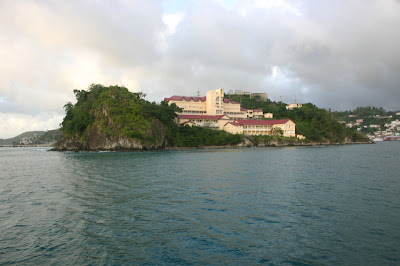Clifton Village, Union Island, St. Vincent & The Grenadines (anchorage)
12° 35.706 N 61° 24.902 W
 |
| Clifton Village, Union Island, St. Vincent & The Grenadines |
Immediately after I unfurled the sail the starboard sheet separated from the clue. John was on that side and saw the event unfold. When that sheet was flying loose it managed to rip the starboard navigation light from the pulpit and sent it to the water. I saw it float by. We had to put the engine in neutral and once again fish a line out of the water. So, we motored the whole way to the next island. Ugh, I hate diesel fumes. On this boat the exhaust is amidships and it is difficult to get away from the smell anywhere on the boat. You’d think with the wind blowing it would be ok but for some reason it isn’t.
I settled in and read in the time-out chair after putting the cheap lure in the water. Within a couple hours we caught another skipjack tuna. I fried it for dinner and made fish tacos sans a couple ingredients.
St. Georges Harbour, Grenada
12° 02.727 N 61° 44.942 W
Grenada is an independent state in the West Indies, comprising the island of Grenada and some of the southern Grenadines. Grenada, in the southeastern Caribbean Sea, is the southernmost of the Windward Islands. The most important of the attached Grenadines is Carriacou, to the northeast. The country has a total area of 133 sq miles; Grenada Island has an area of 120 sq miles. The capital, largest town, and principal port (located on the southwestern coast) is Saint George's.
Grenada is of volcanic origin and is mountainous. The highest peak is Mount Saint Catherine 2,756 ft. Valleys interspersed between the mountains are picturesque and fertile, and many contain swift-flowing streams. The island also has hot springs, several mountain lakes, and excellent beaches. The climate is tropical, with an average annual temperature of 82° F along the coast. Annual rainfall is 60 inches on the coast; a rainy season lasts from June to December. Forests in the interior contain teak and mahogany trees.
The population of Grenada (2004 estimate) is 89,357. The people are predominantly black, and a majority is Roman Catholic. English is the official language, but a French dialect is also spoken. Education is free and compulsory for children between the ages of 5 and 16.
Saint George’s town in southwestern Grenada is the capital of the island nation, in Saint George Parish, in the West Indies. It is a seaport, with a well-sheltered inner harbor, and an administrative, commercial, and tourist center. Refined sugar and alcoholic beverages are principal products. It is a picturesque community, with streets winding up steep hillsides. St. George's was established in 1650 as a French settlement and was the capital of the British dependency of the Windward Islands from 1885 to 1958.
 |
| St. George’s Harbour, Grenada |
The run today was only 40 miles. In the middle it was quite rough with seas that were 8’ or more. The wind was strong and would have made for a great fast sail.
 |
| St. George's Harbor, Grenada |
 |
| Looking aft, west, as we approached the harbor. |
Grenada from a distance at sea and closer up looks like all the islands we have just seen. The joke about same stuff different island really does apply in many ways. But, the buildings looked more colorful and more attractive for what it’s worth.











No comments:
Post a Comment